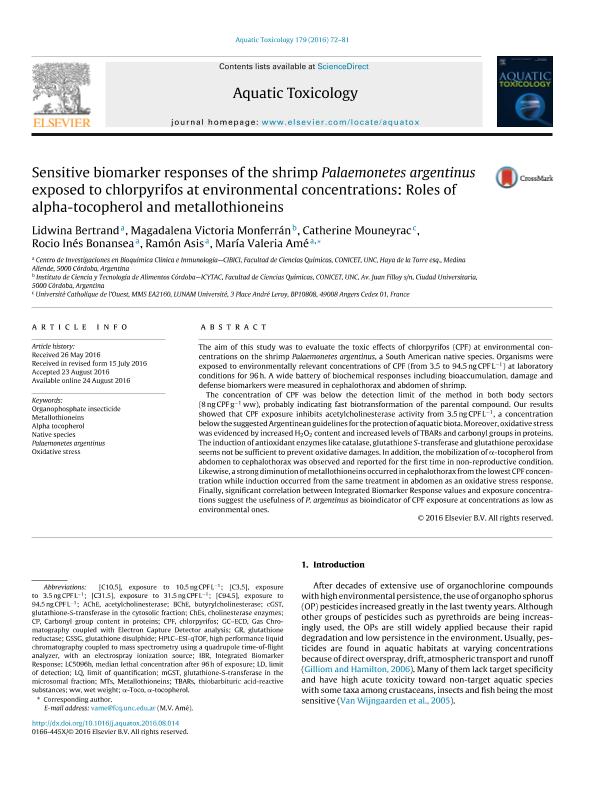Artículo
Sensitive biomarker response of shrimp Palaemonetes argentinus exposed to chlorpyrifos at environmental concentrations: Role of alpha-tocopherol and metallothioneins
Bertrand, Lidwina ; Monferran, Magdalena Victoria
; Monferran, Magdalena Victoria ; Mouneyrac, Catherine; Bonansea, Rocio Ines
; Mouneyrac, Catherine; Bonansea, Rocio Ines ; Asis, Ramón
; Asis, Ramón ; Amé, María Valeria
; Amé, María Valeria
 ; Monferran, Magdalena Victoria
; Monferran, Magdalena Victoria ; Mouneyrac, Catherine; Bonansea, Rocio Ines
; Mouneyrac, Catherine; Bonansea, Rocio Ines ; Asis, Ramón
; Asis, Ramón ; Amé, María Valeria
; Amé, María Valeria
Fecha de publicación:
08/2016
Editorial:
Elsevier Science
Revista:
Aquatic Toxicology
ISSN:
0166-445X
Idioma:
Inglés
Tipo de recurso:
Artículo publicado
Clasificación temática:
Resumen
The aim of this study was to evaluate the toxic effects of chlorpyrifos (CPF) at environmental concentrations over the shrimp Palaemonetes argentinus, a South American native species. Organisms were exposed in laboratory conditions at relevant environmental concentrations of CPF (from 3.5 to 94.5 ng CPF L-1) for 96 h. A wide battery of biochemical responses including bioaccumulation, damage and defense biomarkers were measured in cephalothorax and abdomen of shrimp. The concentration of CPF was below the detection limit of the method in both body sectors (8 ng CPF g-1 ww), probably indicating the fast biotransformation of the parental compound. Our results showed that CPF exposure inhibits acetylcholinesterase activity from 3.5 ng CPF L-1, a concentration below the suggested Argentinean guidelines for the protection of aquatic biota. Moreover, oxidative stress was evidenced by enhanced H2O2 content and increased levels of TBARs and carbonyl groups in proteins. The induction of antioxidant enzymes like catalase, glutathione S-transferase and glutathione peroxidase seems not be sufficient to prevent oxidative damages. In addition, the mobilization of α-tocopherol from abdomen to cephalothorax was observed and reported for the first time in non-reproductive condition. Likewise, a strong diminution of metallothioneins occurred in cephalothorax from the lowest CPF concentration while induction occurred from the same treatment in abdomen as an oxidative stress response. Finally, significant correlation between Integrated Biomarkers Response values and exposure concentrations suggest the usefulness of P. argentinus as bioindicator of CPF exposure at low dose as environmental concentrations.
Archivos asociados
Licencia
Identificadores
Colecciones
Articulos(ICYTAC)
Articulos de INST. DE CIENCIA Y TECNOLOGIA DE ALIMENTOS CORDOBA
Articulos de INST. DE CIENCIA Y TECNOLOGIA DE ALIMENTOS CORDOBA
Citación
Bertrand, Lidwina; Monferran, Magdalena Victoria; Mouneyrac, Catherine; Bonansea, Rocio Ines; Asis, Ramón; et al.; Sensitive biomarker response of shrimp Palaemonetes argentinus exposed to chlorpyrifos at environmental concentrations: Role of alpha-tocopherol and metallothioneins; Elsevier Science; Aquatic Toxicology; 179; 8-2016; 72-81
Compartir
Altmétricas



